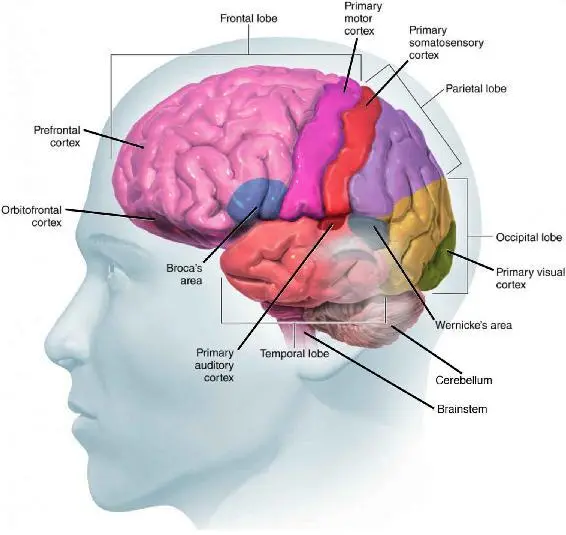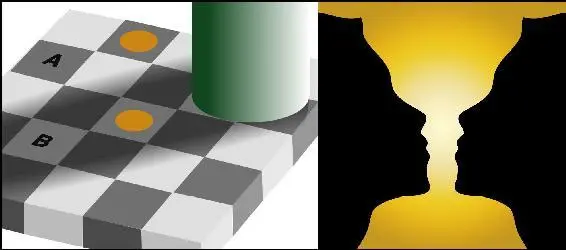
Figure 8.3: The visual, auditory, somatosensory and motor cortices are involved with vision, hearing, the sense of touch and motion activation, respectively—but that doesn’t prove they’re where consciousness of vision, hearing, touch and motion occurs. Indeed, recent research suggests that the primary visual cortex is completely unconscious, together with the cerebellum and brainstem. Image courtesy of Lachina (www.lachina.com).
Although Francis Crick warned Christof Koch about studying consciousness, Christof refused to give up and and eventually won Francis over. In 1990, they wrote a seminal paper about what they called “neural correlates of consciousness” (NCCs), asking which specific brain processes corresponded to conscious experiences. For thousands of years, thinkers had had access to the information processing in their brains only via their subjective experience and behavior. Crick and Koch pointed out that brain-reading technology was suddenly providing independent access to this information, allowing scientific study of which information processing corresponded to what conscious experience. Sure enough, technology-driven measurements have by now turned the quest for NCCs into quite a mainstream part of neuroscience, one whose thousands of publications extend into even the most prestigious journals.10
What are the conclusions so far? To get a flavor for NCC detective work, let’s first ask whether your retina is conscious, or whether it’s merely a zombie system that records visual information, processes it and sends it on to a system downstream in your brain where your subjective visual experience occurs. In the left panel of figure 8.4, which square is darker: the one labeled A or B? A, right? No, they’re in fact identically colored, which you can verify by looking at them through small holes between your fingers. This proves that your visual experience can’t reside entirely in your retina, since if it did, they’d look the same.
Now look at the right panel of figure 8.4. Do you see two women or a vase? If you look long enough, you’ll subjectively experience both in succession, even though the information reaching your retina remains the same. By measuring what happens in your brain during the two situations, one can tease apart what makes the difference—and it’s not the retina, which behaves identically in both cases.
The death blow to the conscious-retina hypothesis comes from a technique called “continuous flash suppression” pioneered by Christof Koch, Stanislas Dehaene and collaborators: it’s been discovered that if you make one of your eyes watch a complicated sequence of rapidly changing patterns, then this will distract your visual system to such an extent that you’ll be completely unaware of a still image shown to the other eye.11 In summary, you can have a visual image in your retina without experiencing it, and you can (while dreaming) experience an image without it being on your retina. This proves that your two retinas don’t host your visual consciousness any more than a video camera does, even though they perform complicated computations involving over a hundred million neurons.

Figure 8.4: Which square is darker—A or B? What do you see on the right—a vase, two women or both in succession? Illusions such as these prove that your visual consciousness can’t be in your eyes or other early stages of your visual system, because it doesn’t depend only on what’s in the picture.
NCC researchers also use continuous flash suppression, unstable visual/auditory illusions and other tricks to pinpoint which of your brain regions are responsible for each of your conscious experiences. The basic strategy is to compare what your neurons are doing in two situations where essentially everything (including your sensory input) is the same—except your conscious experience. The parts of your brain that are measured to behave differently are then identified as NCCs.
Such NCC research has proven that none of your consciousness resides in your gut, even though that’s the location of your enteric nervous system with its whopping half-billion neurons that compute how to optimally digest your food; feelings such as hunger and nausea are instead produced in your brain. Similarly, none of your consciousness appears to reside in the brainstem, the bottom part of the brain that connects to the spinal cord and controls breathing, heart rate and blood pressure. More shockingly, your consciousness doesn’t appear to extend to your cerebellum (figure 8.3), which contains about two-thirds of all your neurons: patients whose cerebellum is destroyed experience slurred speech and clumsy motion reminiscent of a drunkard, but remain fully conscious.
The question of which parts of your brain are responsible for consciousness remains open and controversial. Some recent NCC research suggests that your consciousness mainly resides in a “hot zone” involving the thalamus (near the middle of your brain) and the rear part of the cortex (the outer brain layer consisting of a crumpled-up six-layer sheet which, if flattened out, would have the area of a large dinner napkin).12 This same research controversially suggests that the primary visual cortex at the very back of the head is an exception to this, being as unconscious as your eyeballs and your retinas.
When Is Consciousness?
So far, we’ve looked at experimental clues regarding what types of information processing are conscious and where consciousness occurs. But when does it occur? When I was a kid, I used to think that we become conscious of events as they happen, with absolutely no time lag or delay. Although that’s still how it subjectively feels to me, it clearly can’t be correct, since it takes time for my brain to process the information that enters via my sensory organs. NCC researchers have carefully measured how long, and Christof Koch’s summary is that it takes about a quarter of a second from when light enters your eye from a complex object until you consciously perceive seeing it as what it is.13 This means that if you’re driving down a highway at fifty-five miles per hour and suddenly see a squirrel a few meters in front of you, it’s too late for you to do anything about it, because you’ve already run over it!
In summary, your consiousness lives in the past, with Christof Koch estimating that it lags behind the outside world by about a quarter second. Intriguingly, you can often react to things faster than you can become conscious of them, which proves that the information processing in charge of your most rapid reactions must be unconscious. For example, if a foreign object approaches your eye, your blink reflex can close your eyelid within a mere tenth of a second. It’s as if one of your brain systems receives ominous information from the visual system, computes that your eye is in danger of getting struck, emails your eye muscles instructions to blink and simultaneously emails the conscious part of your brain saying “Hey, we’re going to blink.” By the time this email has been read and included into your conscious experience, the blink has already happened.
Indeed, the system that reads that email is continually bombarded with messages from all over your body, some more delayed than others. It takes longer for nerve signals to reach your brain from your fingers than from your face because of distance, and it takes longer for you to analyze images than sounds because it’s more complicated—which is why Olympic races are started with a bang rather than with a visual cue. Yet if you touch your nose, you consciously experience the sensation on your nose and fingertip as simultaneous, and if you clap your hands, you see, hear and feel the clap at exactly the same time.14 This means that your full conscious experience of an event isn’t created until the last slowpoke email reports have trickled in and been analyzed.
Читать дальше














